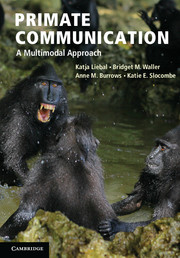Book contents
- Frontmatter
- Contents
- Preface
- Acknowledgements
- Part I Introduction to primate communication
- Part II Approaches to primate communication
- 4 The methods used in primate communication
- 5 A multimodal approach to primate communication1
- Part III Cognitive characteristics of primate communication
- Part IV Approaches to the evolution of primate communication
- Glossary
- References
- Species index
- Subject index
5 - A multimodal approach to primate communication1
Published online by Cambridge University Press: 05 December 2013
- Frontmatter
- Contents
- Preface
- Acknowledgements
- Part I Introduction to primate communication
- Part II Approaches to primate communication
- 4 The methods used in primate communication
- 5 A multimodal approach to primate communication1
- Part III Cognitive characteristics of primate communication
- Part IV Approaches to the evolution of primate communication
- Glossary
- References
- Species index
- Subject index
Summary
What kind of research has been done on primate communication?
When the authors decided to write this book our impression was that primate communication studies overwhelmingly focused on a single communicative modality, be that vocalizations, manual gestures, olfaction or facial displays. Each of us had expertise in each of these four areas, yet we agreed we were irritatingly ignorant as to the methods and findings of scientists operating outside of our own modalities. In particular we discussed how difficult it was to directly compare and integrate findings from our respective modalities to create a coherent understanding of primate communication as a whole. These conversations were not only the catalyst for this book, but also for a systematic review of the current primate communication research, in order to examine the patterns and biases that are present in the literature as it stands. This systematic review is published as an essay in Animal Behaviour (Slocombe, Waller and Liebal, 2011), and the key points will be reviewed here.
In order to gain an accurate picture of the current state of the primate communication literature, we conducted a systematic search for research conducted on primate communication from 1960–2008. This search was not designed to be exhaustive, but to provide a representative snapshot of the kind of empirical research being published on primate communication. We used a standard set of search terms in three major relevant databases (Web of Science, Science Direct and PrimateLit; see footnote for search terms). As this is a large and greatly varied field, we applied a set of criteria to all studies returned by the searches: we excluded all non-empirical studies (e.g. reviews, essays, opinions), all non-peer-reviewed material (e.g. books, book chapters, conference proceedings) and as we were interested in spontaneous communication, we also excluded all studies where primates were asked to interpret human signals or use artificial language systems. As one original aim of this review was to examine how primate communication literature is used in debates about language evolution, we focused on the three main modalities that are most relevant to this topic (vocalization, gesture, facial) and we thus excluded studies that focused solely on olfactory communication. Finally, we included only those studies that had been published in English, in order for us to be able to assess it properly.
- Type
- Chapter
- Information
- Primate CommunicationA Multimodal Approach, pp. 104 - 128Publisher: Cambridge University PressPrint publication year: 2013
- 1
- Cited by



